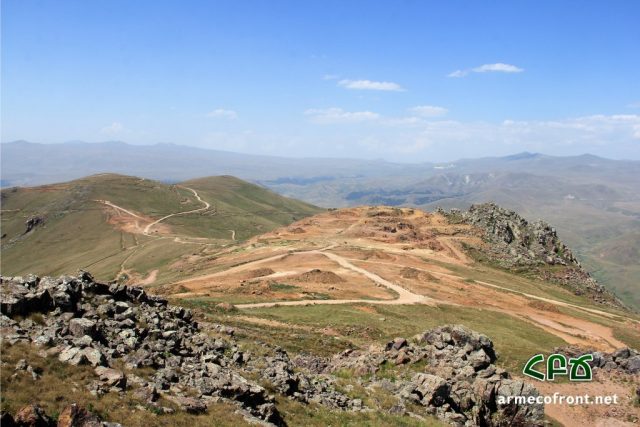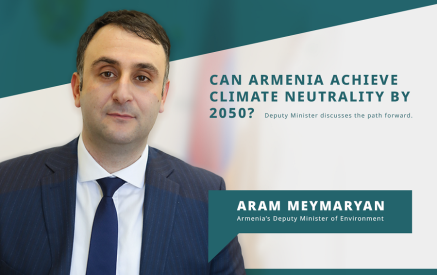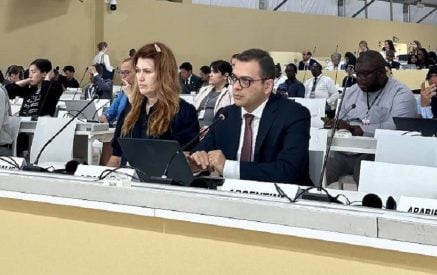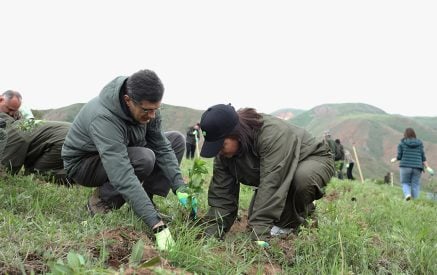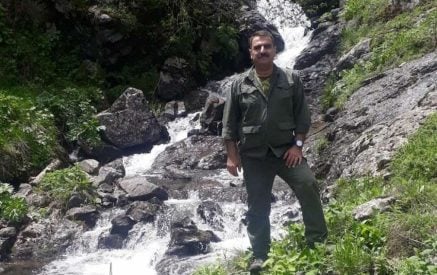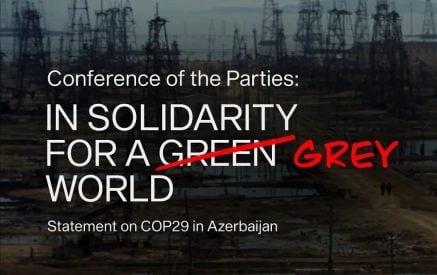On the 26th of October 2017 Armenian Environmental Front civil initiative sent a letter to EBRD, as well as to its office in Armenia regarding EBRD’s financing of Lydian International and its gold mining project in Armenia which raises a lot of concerns among the civil society and environmental groups in Armenia. We are expecting an answer. The content of the letter below:
“Dear addressee,
EBRD is a shareholder in Lydian International, a company that plans to realize a gold mine project in Amulsar. Initially EBRD’s investment in the gold mine project in Amulsar was used for exploration activities. Afterwards, the Bank had plans to invest up to CAD 10.5 million (~8mln USD) to purchase the company’s shares as part of its capital increase.
Among investors in this project was International Finance Corporation, which, as of May 2017, has withdrawn from the project.
Since the beginning of this project there has been an opposition to this project from local communities and environmental groups. Since 2011 and up to date, there have been numerous protest actions in Yerevan and Jermuk, discussion, critical articles, petitions and court appeals (in Armenia and Aarhus Committee). Also in addition to complaints submitted to IFC’s CAO, the residents of Gndevaz and Jermuk communities together with several environmental NGOs in Armenia had submitted two complaints to PCM Officer (complaint 1, complaint 2) with regard to EBRD’s investment in Lydian International Limited. The complainants highlighted concerns about project impacts on the local water basins’ quality, risks with uranium deposits near the mining sight, red-listed species and a local tourism center.
Other issues raised included criticisms of the Environmental Impact Assessment (EIA) conducted and alleged violations of EBRD standards and principles of environmental and social responsibility and national regulations. EBRD refused to process those complaints explaining that it does not support the mining but only the exploration. The situation is different now, the mining operations have been approved by the Government of Armenia and have started by Lydian Armenia, EBRD still supports it, and therefore, we repeat our complaint and ask for explanation from EBRD:
Why is EBRD funding a project which fails to comply with the Bank’s approaches to sustainable mining that are described in EBRD mining operations policy, particularly: environmental and social issues, water management, health management, materials management (cyanide), and biodiversity?
The project of Lydian Armenia fails to answer a number of questions and concerns with regard to unmanageable risks connected with the geological structure of the area and water resources. Independent expert analyses (such as those from Buka Environment, Clear Coast Consulting, Inc, Blue Minerals Consultancy) prove that this mining project is very likely to cause long term consequences for the entire area, and the risks may have an impact on EBRD as well for which you can be held liable.
Therefore, we would like to draw your attention to several serious issues and get answers from you regarding the following;
In the technical report of Samuel Engineering made for Lydian International, the former recommends the Lydian that “Unlike active treatment systems, a Passive Treatment System (PTS) must be designed to function under site‐specific conditions. To date, no studies have been performed to ascertain the performance of PTS methods on Amulsar Acid Rock Drainage. A process verification study must be performed. This study includes bench‐scale and pilot‐scale tests.” “The process verification studies are long‐duration tests that will start during final design and continue into production. Process verification studies are anticipated to cost approximately $405,000.”
Now, the problem is that Lydian should have done the complete evaluation of the project before getting a permit and starting work on the project. However it has been 12 years that Lydian is unable to complete its evaluation. This shows their inexperience and lack of adhering to any international standards and proper contractual conditions and obligations.
Moreover, this technical report dating to March 30, 2017 is totally a new addition that was not included in the permit given by Armenia’s Ministry of Nature Protection in 2016, proving that today Lydian does not have any ARD (Acid Rock Drainage) management plan and as a result they do not even have a valid ESIA. Therefore their 2016 permit must be re-evaluated. The progress should have been therefore stopped until all the evaluation was done. Otherwise the quality and quantity of produced ARD and its impact near the mine stays unclear. The topography https://goo.gl/l5pWkJ, and the aerial imagery https://goo.gl/G6wrbz shows the vast water resources that will be directly negatively affected by this project.
The independent experts that reviewed this document advice not to start the mining “until the environmental outstanding issues are properly investigated by independent bodies/consultants. Their findings should be incorporated into an acid and metalliferous drainage (AMD) management plan that includes and makes explicit both government and company responsibilities and liabilities.
Therefore, the question is why EBRD is funding a project when there is a lack of complete evaluation of this project? Has corresponding experts at EBRD reviewed the ESIA of Lydian prior to giving a green light to EBRD for funding this project? If there has been a review, how could they omit the lack of full evaluation of the ARD management plan? Note that Lydian is not a member of International Network for Acid Prevention, while Acid Rock Drainage is the major problem at Amulsar.
The question is thus if EBRD funds a project like this with serious omissions, is it also taking the responsibility for any fault that might occur during the mine operation?
Other factors EBRD might want to consider are – Newmont, a highly experienced and financially strong company quitting working with Lydian, and then IFC divesting its investment in Lydian and no longer being a shareholder in the company.
Some more risks below:
- Affecting water resources and the risk of acid rock drainage
Amulsar is a sulphide mine (also stated in Geoteam’s early mineral exploration documents), therefore the water flowing through sulphide rocks will turn into reactive acid water creating acid drainage. The open mine area will be exposed to snow, rain and artificial watering, the streams originating in the open mine area will flow over the surface of the stripped area and downstream the mountain and will penetrate deep into the ground. Amulsar mountain is formed of cracked volcanic rocks and there is no method or technology to stop the water from penetrating into these rocks and thus flowing further into the ground. The latter will not only erode the iron concrete construction of the Vorotan-Arpa water tunnel that is located in the immediate vicinity of the planned mining area, but will also infiltrate into the water flowing through the tunnel into Lake Sevan and will ultimately alter the lake’s chemical composition. Lake Sevan is a unique large fresh water reservoir and a strategic water resource from the entire region of South Caucasus. This risk is also confirmed by a fact that not far from the mining site, right on Amulsar’s slope there is a small natural pond of diluted acid. In June 2017, three well known international independent expert groups (from Australia, USA and Canada) studied dozens of documents available on Lydian International company’s website and presented their assessments and conclusions on number of environmental risk of the gold project in Amulsar, and acid rock drainage is one of the main unmanageable risks.
Another risk for water resources is associated with Jermuk, a health resort town famous for its healing mineral waters, only 12 km away from the mine and not even included in the ESIA until 2016. Lydian excludes any negative impact of the mining activities on the mineral waters and insists that an isotope analysis confirmed that these waters have no physical connection to Amulsar’s hydrological systems. However, scientific data (source: Geomorphology of Armenian SSR, 1986, pp. 134-145) (source 1, source 2) states the opposite: in relatively recent geological past, this area was the paleochannel of the Arpa-Vorotan river basin. Vorotan river has been connected to the Arpa river basin, they were one river (upper pliocene-lower quaternary geological period). Vorotan river’s upper basin and Arpa river were separated after Amulsar’s lateral raise. This means that deep mineral and underground waters are still connected.
The ESIA has numerous other gaps regarding the assessment of impact on water resources. These gaps are mentioned in detail in the petition of 8 environmental NGOs to the government of Armenia, dated March 10, 2017 (available only in Armenian yet). The NGOs and their experts exposed a number of methodological errors in the ESIA, contradictory facts presented in different documents of Lydian and a lack of grounded expert assessment which should prevent such a project from being carried out.
- Heap leaching with sodium cyanide
The usage of sodium cyanide for heap leaching (1000 tons annually) contains primary and secondary risks, which are often unmanageable and uncontrollable. Primary risks include fires in cyanide storehouses, accidents in technical structures, leaks of highly hazardous substances, natural disasters, terrorist and military actions, and other similar accidents with grave effects on people, as well as nature. Secondary risks have even more complex origins and their impacts may last forever. Ore containing gold and silver is crushed as a result of which all elements (or metal and non metal compounds) in the ore are separated. This substance is processed with water and cyanide mixture, and as a result of chemical reaction the gold is separated. However the reaction takes place not only between cyanide and gold but also between cyanide and other elements in the ore, including heavy metals, as a result of which nitrates and other chemical compounds are formed. There are many more heavy metals in the ore in Amulsar than gold, including cobalt, copper, iron, nickel, mercury, zinc, wolfram, bismuth, chromium, lead, as well as poisonous substances such as arsenic, selenium, tellurium, beryllium, cadmium, which will seriously pollute and threaten nature, ecosystem and humans health if they remain in the waste. Risks of pollution cannot be ignored in the case of Amulsar, because its territory is located in a seismic area, in a tectonically active and landslide zone. Even a few millimeters of ground movement annually will be enough to destabilize the protective layers and structures and to cause an ecological disaster in Vayots Dzor region. Similarly, risk exists in case of technical problems and leaks that may also occur in the heap leach facility that will be located on the shores of Arpa river and some 1000 meters away from Gndevaz village (case of Bellavista mine is well known for us to understand the risks). From year 5 of the project activity, Lydian plans to extract the remains of cyanide from the heap-leach water and release it to Arpa river; the same solution is planned in case of technical accidents. The company hides information about the fact that this water will contain not only cyanide but also a large number of heavy metals (see more details in the next point).
Another risk related to this topic is that sodium cyanide will be transported to the mining site by road (there is no railway there) which means that dozens of towns and villages on the way to Amulsar will be at risk in case of any accidents of leak of cyanide during its transportation to the mining site. Note, the cyanide route, transportation and handling have not been part of ESIA and have not been duly examined and approved.
- Communities downstream Arpa river
The mining project contains risks towards communities living downstream Arpa river. According to the ESIA of Lydian Armenia, these communities are not even considered to be affected communities. However, as the mining project states, the company will collect all the industrial waters for 5 years, afterwards, they will carry out a cyanide treatment and release the water to Arpa river. While cyanide can indeed be neutralised in water, other heavy metals will remain. What is going to happen to arsenium, zinc, and other metals available in the industrial waters? The project lacks any mention of treatment for heavy metals before releasing the water to Arpa river. Meanwhile, Arpa is the main source of irrigation water for at least 5 large villages which are among largest agricultural and wine producers in the country, and some local producers have even certified their products as organic. These people have not at all been informed about the grave risks to which they will be exposed in case mining in Amulsar happens. Risks of contamination of Arpa river and therefore, also massive agricultural lands are ignored in the ESIA.
- Active opposition and protests
The environmental community in Armenia and beyond, as well as local communities are actively opposing to the project. As soon as information about exploration in Amulsar became public, there has always been opposition towards this project in Armenia. The local communities were totally against the mine which was clear from the public hearings (more public hearing), from protest actions and refusal to sell lands for years (the state eventually declared eminent domain over those lands, who were not selling them). Independent experts and even the state expert committee on Lake Sevan have given negative opinions about mining in this area. Since 2011 and up to date, there have been numerous protest actions in Yerevan and Jermuk, discussion, critical articles, petitions, court appeals (in Armenia and Aarhus committee). An ongoing petition with more than 5000 signatures demands to stop financing the project. Recently a documentary was presented to public about dangers of the gold mine project available here for anyone who has no clear picture of dangers of this project.
Since 2 years, representatives of Gndevaz village community are disputing in the Administrative Court of Armenia the approval of the ESIA by the relevant ministries of Armenia; they state that the government has approved the mining project without carrying out due legal procedures and without due expert analyses of the documents presented by Lydian Armenia. Recently, “EcoRight” and “EcoDar” NGOs, which parallel to residents of Gndevaz Community had lodged a claim against the permitting documents of Amulsar gold mining project, were left out of the litigation process based on the court decision, which is against the rulings of the Aarhus Convention Compliance Committee issued earlier for a similar matter.
We strongly believe that by funding and supporting this project EBRD is failing to comply with its own policies and with the compliance standards which it shares with the International Finance Institutions. We request the answer to our question on why the Bank continues to support this project. We pledge EBRD to withdraw from Amulsar project and stop supporting it in any way.
Best regards,
–Armenian Environmental Front (AEF) Civil Initiative (email: [email protected])
-Greens Union of Armenia
-“Environmental Public Society” NGO
-“Ecological Academy” NGO
-“Environmental Sustainability Assistance Center” NGO
-“Jermuk Development Center” NGO
-Prof. Armen Saghatelyan, DSc (geochemistry, geology), Director of the Center for Ecological-Noosphere Studies of the National Academy of Sciences
-Tehmine Yenoqyan, reporter”
| Website: https://www.armecofront.net/en/ Facebook page: https://www.facebook.com/armecofront YouTube: https://www.youtube.com/user/armecofront
|




















































